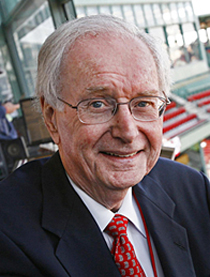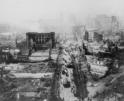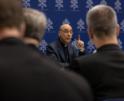
Culture
So how did the Ruth deal work out for the Yankees, anyhow? Well, in his first year in New York, he hit more home runs, 54, than any other entire team in the American League, and in the process became the greatest gate attraction in baseball history.

Flavin
The Curse of the Bambino is a misnomer. It's not that there wasn't a curse put on the Boston Red Sox when the sale of Babe Ruth to the New York Yankees was made public 100 years ago this week; obviously, if you follow baseball, you know that there was. I just don't think it's fair to blame the curse on Ruth, who had loved his time in Boston.
There are people who don't believe in curses, who don't think there are evil spirits out there in the firmament that can cause doom and raise havoc. Those people have not studied the history of the Red Sox.
But the anguish the Sox suffered for the 86 years shouldn't be known as the Curse of the Bambino, it should rightfully be labeled the Hex of Harry Frazee.
When the sale of Ruth, for the then unheard of price of $100,000, was announced, Red Sox fans thought it was the end of the world. It wasn't, of course. It was just the beginning of the end. What was not announced was that Yankees co-owner, Jake Ruppert, gave Red Sox owner Harry Frazee a loan of $300,000 dollars with Fenway Park as collateral. That, boys and girls, was the end of the world.
Ruppert had something that Frazee wanted and needed -- cash, and plenty of it. And Frazee had something that Ruppert wanted and needed -- Babe Ruth. So, they did the deal. When Frazee bought the Sox from Joseph Lannin in 1916, the outgoing owner gave him a loan of $262,000 to help him meet the asking price. In November 1919, though, he called in the note. Harry, whose Broadway producing business was in a slump, needed cash, and he needed it fast, to pay off Lannin. Enter Colonel Jake, he of the deep pockets. He was more than willing to help out his pal (he and Frazee had their offices in the same building). All Harry had to do in return was sell his soul, plus Ruth, of course.
The result was that Ruppert held the mortgage on Fenway Park and he could call the loan at any time. He might not have owned the Red Sox, but he did own the Red Sox owner.
Added to that is the fact that Harry was never a Boston guy in the first place. Though he owned the Red Sox he never made Boston his base of operation. Jane Leavy, author of the wonderful Babe Ruth biography, "The Big Fella," quotes Frazee's grandson as saying that Harry's favorite thing about Boston was, "the train ride home to New York."
So how did the Ruth deal work out for the Yankees, anyhow? Well, in his first year in New York, he hit more home runs, 54, than any other entire team in the American League, and in the process became the greatest gate attraction in baseball history. Yankee attendance more than doubled and they became the first team ever to draw over 1,000,000 fans. In just one season, Ruth more than paid for the investment Ruppert had made. But the Yanks finished in just third place. They needed still more talent -- and Jake Ruppert knew where to get it.
The Red Sox still had a talent-rich roster, so as soon as the 1920 season was over, Ruppert hired the man who knew more about that roster than anyone else to be the Yankees general manager; Ed Barrow, who was the current Red Sox manager. Harry Frazee (surprise, surprise!) did not object to the poaching of the Sox skipper.
Once he was settled in his new job, Barrow got busy cherry-picking the Red Sox roster of its best players. That December, the Yankees bought a young Sox pitcher, Waite Hoyt, who would have a Hall of Fame career to go with his 237 wins, plus starting catcher Wally Schang, for a few fringe players and the thing Harry Frazee loved most, cash.
Over the following two off-seasons, Frazee sold to the Yankees pitchers Sam Jones (229 wins), Joe Bush (195 wins), Herb Pennock (Hall of Fame, 240 wins), and George Pipgras (102 wins); plus shortstop Everett Scott, and third baseman Jumpin' Joe Dugan. All the deals were for cash and a few spare part players. When the Yankees won their first ever world series in 1923, Bob Shawkey was the only pitcher on the staff that won a game who had not been sold to them by Harry Frazee. The catcher, shortstop and third baseman were all Red Sox alumni sold to them by Harry Frazee. Oh yes, so was the guy in right field, who hit .393 that year and was by then as famous as the president of the United States.
The cash Harry received in those deals did not go to the Red Sox, who were by then dead last in the American League. It was used to support his fast-lane lifestyle and to shore up his theatrical prodution business.
Finally, with all the Red Sox assets sold off to New York, Frazee sold the team, by then in ruins, in June of 1923. The '20s decade, which had begun with the announcement of Ruth's sale, ended with Frazee's death, on June 4, 1929, of Bright's Disease.
But his ghost lived on; Harry's Hex continued to haunt the Red Sox. How else does one explain a routine fly ball hit by Bucky Dent of the dreaded Yankees mysteriously floating over Fenway's left field wall? Or Bill Buckner losing consciousness just as a he was about to field a routine ground ball? Or Grady Little suddenly forgetting that he had a bullpen in the seventh game of a playoff series against the (you guessed it) Yankees? Surely those horrible happenings cannot be dismissed as mere coincidences. And now that we've let the Babe off the hook, who better to blame than Harry?
Red Sox Nation feels secure that the Curse of the Bambino was stamped out back in 2004, but what if there never was such a curse? What if it was the Hex of Harry all along? Then we have to deal with the fact that ghosts don't die. The ghost of Harry Frazee could still be out there somewhere, waiting to strike again. We can only hope that it's on the train ride back to New York.
- Dick Flavin is a New York Times bestselling author; the Boston Red Sox "Poet Laureate" and The Pilot's recently minted Sports' columnist.
Recent articles in the Culture & Events section
-
Boston and the nation respond to the San Francisco Earthquake of 1906Thomas Lester
-
See you in the storyLaura Kelly Fanucci
-
'Dignitas' and the mediaRussell Shaw
-
Scripture Reflection for April 14, 2024, Third Sunday of EasterDeacon Greg Kandra
-
St. Helena's House is established in the South EndThomas Lester


















